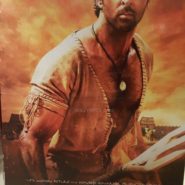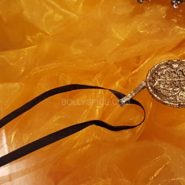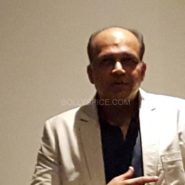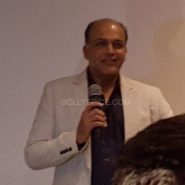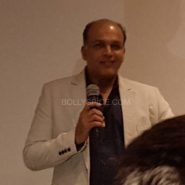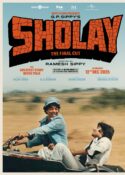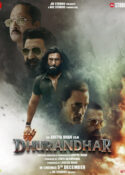 BollySpice attended a press conference with the Mohenjo Daro director Ashutosh Gowariker, where we got a sneak peek at his upcoming release starring Hrithik Roshan and Pooja. Here is what he had to say on the film in his own words…
BollySpice attended a press conference with the Mohenjo Daro director Ashutosh Gowariker, where we got a sneak peek at his upcoming release starring Hrithik Roshan and Pooja. Here is what he had to say on the film in his own words…
Why Mohenjo Daro…
It is a civilisation that has fascinated me for many many years. I came face to face with it many times throughout my life, at very undecided, unplanned quarters; like museums, I would get enamoured by artifacts, or when I was doing Lagaan, I was travelling in Bhuj looking for locations I stumbled upon Dholavira, a city which is an excavation site. For some time I kept on feeling that I must make a movie on this. I was hoping that I get the opportunity to do that and that opportunity came to me in the form of Hrithik as well as UTV.
What fascinated me was – what is this civilisation? Who are these people? What was their society? What kind of politics did they have? What kind of religion did they have? What did they believe in? What are the manners and morals of society? If I focus only on these aspects and not have a story then it could easily have become a documentary. So a story was a must. That is what I have weaved in based on all the excavation facts that have been found.
I took the help of a lot of archaeologists especially Dr Jonathan Mark Kenoyer (Department of Anthropology – University of Wisconsin). He has spent 35 in Mohenjo Daro. Ajit Prasad, Krishnan, Vasant Shinde, Prabakhar, these are the archologists who have worked in India on the Indian sites. I essentially needed all the information you could give me to build my story.
On ‘Tu Hai’…
There are six animals that represented every city at that time, could be, let me not say emphatically, let me say could be. So these animals are the bull, the elephant, the rhino, the deer, and the unicorn, or the one horned animal which is something very mythical. And Tu Hai focuses on that and the reverse Sindhu.
The reverse Sindhu in my learning, in my study, I realised that they believed in the elements. They believed in water, they believed in the sun, they believed in the land which gives them food, so the river became a very big lifeline.’ Tu Hai’ is in praise of the river.
On doing period films…
Actually these are different eras. When I made Lagaan it was the British era – it is categorised as modern India. When I did Jodha Akbar it was Mugal. I was planning to make a film on Buddha which would have categorised as ancient India but Mohenjo Daro is going way back. It is pre – history. There is nothing written about this. All facts that are being revealed to us are only by excavation, by artifacts that have been found. I found that most fascinating. I think I will stop there and come back to contemporary cinema.
On using his imagination in the making of Mohenjo Daro…
I did it in two phases. My phase one was just chatting with the archaeologists, going over all the discoveries that have been made to date. So all the information you find in the scenes all the figurines are there. Even the figurines have a lot of evidence of the type of head dresses that they had, the kind of wardrobe that they had. 80% of the figurines, the women are naked. Obviously I didn’t want to go that way because you can’t have a film based on that type of look. I had to fill in the blanks somewhere, keep what was in the figurines and to build from imagination from there.
They use a lot of precious stone, stones which they call precious but are actually from the river bed. They use a lot of feathers of animals to adorn themselves, they use rose petals for their lips, that kind of information I tried to piece in.
As far as the romance and the politics of the film is concerned, that I have built it by studying other civilisations that were present at this time. The Indus Valley had a lot of trade happening with the Egyptian and Sumerian civilisation, so there was a cultural exchange. There was a lot of exchange that happened so there could be some common things that went to and fro.
As far as the river (Sindhu) is concerned, there are certain idols, figurines that the archaeologists have determined are symbols of a river goddess. I have used those aspects. History is such that you have so many different chains of thoughts, so many different lines that it is difficult to incorporate them all. I had to make a choice, so I decided to go with Dr Jonathan Mark Kenoyer and the other archaeologists I mentioned earlier and build my story from there. There will be a lot of reservations on certain things. I cannot say they are wrong in their reservations, but neither can they say I am wrong because nobody knows. I have created a make believe world, so it is probably my make believe world. I have tried to stay as honest as possible to what could have been.
On the characters…
They are not based on fact. We know Indigo farming was done. Farming was their main occupation. Evidence like that has been used. Sarman (Hrithik) is an Indigofarmer.
The unicorn is a mythical animal so trying to see how that myth can be incorporated. Stuff like that, there has been an amalgamation of fact and fiction.
Hrithik was my first choice, and I am very glad that it materialised. Hirthik has the ability to make any world believable. It is what I feel when I observe him as an actor. He has the ability to create certain convictions within the created world. What I am saying, it’s not a Jodha Akbar, he can even be the role created in Guzzarish, he can even be the role he is going to be in Mohenjo Daro because he tends to do very different things and he tries to do them with a lot of conviction. So for me, for Mohenjo Daro, he was the first choice and I hope he makes the world believable for the audience.
Sunita (Gowarikar) spotted Pooja in an advert and said this is the girl to play the female lead. For quite some time we were looking for the right choice. Someone who can have dignity and grace, hold a shot without saying anything, without saying a single word, a dialogue. That was becoming a task, till Sunita spotted Pooja in an advert.
We called her in an we did a couple of scenes with her. She is extremely sharp on the uptake. Essentially what does a director want, an actor that understands what he is trying to convey, adapt it, internalise it, and give it body, which I think she (Pooja) does very well. It came very naturally to her. Of course we went through the grind of making her do a song where she performed a number; we wanted to see how good was her grace, which helped. So after a series of auditions, we talked to her.
On the Language…
The script of Sindhu is still undeciphered. People are still making several attempts. There are 50 different theories about what the Sindhu script could have been. It is probably the only language that has not been deciphered. It was tricky for me, what to do and how to use that in the movie. Some theories say that it is Prakrit and Brauhi that it goes back to. I decided to use Hindi as the language medium, but I tried to use a Hindi which is not very Sanskritised, but at the same time a little modern. Certain words that are probably used in the Sindhi language, some words are used on the border that we share right now with Pakistan. So it is a mesh of languages to give it a different feel, otherwise it becomes very contemporary and close to our day to day life today. Certain words are pre-historic, possibly at the cost of alienating the audience a bit but I think it is necessary, to allow the audience to enter that world.
On the Location/Sets…
I feel this was our first civilisation in this part of the world. We only have facts, we only have information. We have not created anything make believe from the information that is out there. So for me creation was twofold. One was architecture, so if you see the great bath in ‘Tu Hai’, it is exactly the same size that is in present day Mohenjo Daro excavation site. If you see the pillars and columns, the size of the houses, it’s all probably what could have been. So it’s certain things that allowed me to stay within the boundaries of storytelling. And of course the romance I had to create something that is believable within that space.
On the pressures of including a love story…
I couldn’t have made a film on the Mohenjo Daro civilisation without weaving a love story into it. When you pick a culture like this civilisation, there are certain common elements that come into play. There has to be a hero, there has to be a villain, and there has to be a heroine. They are the three necessary ingredients. Within that the romance becomes very important; otherwise it is difficult to convince an audience of a civilisation. There are many instances of other movies that have been made even in Hollywood where they have done it without these ingredients and these films have not worked because somewhere I think we, when we go to see a movie we want to be entertained. Of course we want to see great sets and property and lush colours, but only after we see the hero and heroine, so the romance becomes important. I don’t think I would have made this film without the romance.
Mohenjo Daro release’s on 12th August

